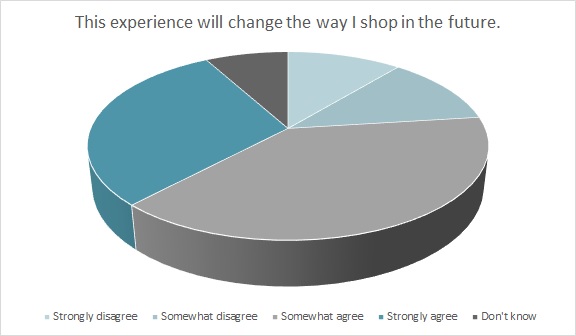Now that we’re firmly enmeshed in the New Year, it would be nice if 2020 were a distant memory. But COVID-19 is still incredibly overbearing, not least of which for the apparel industry. Not only did the pandemic slam then reshape clothes shopping habits last year, but analysts say it will continue to affect consumer trends this year, and potentially for years to come.
Heightened interest in casual apparel, shopping conveniences and digital engagement are just a few of the trends marketers should be prepared for as shifts take place across all channels. [quote]
Euromonitor International’s “Top 10 Global Consumer Trends 2021” report says the pandemic helped to establish, influence, or escalate each of their trends.
“Emerging habits accelerated, and how we now behave, spend and consume will never be the same,” the Euromonitor trends report states. “We want new ways to make life both convenient and safe, inside and outside. Where we have the ability, we are balancing our time creatively. Amidst the anxiety and turmoil, we seek holistic, resilient solutions and more thoughtful consumption.”
The majority of consumers (65 percent) are very concerned personally about the COVID-19 pandemic, according to Cotton Incorporated’s November 2020 U.S. Coronavirus Response Survey, Wave 4. The respondents were surveyed before new strains of the virus entered the United States. Dr. Anthony Fauci, President Biden’s chief medical advisor, recently said the new U.K. variant is not only more transmissible, but more deadly than the original virus. Additionally, a new South African strain might diminish the efficacy of vaccines that have been slow to reach Americans.
It’s no wonder then, that nearly 7 in 10 consumers (69 percent) say the COVID-19 experience will change the way they shop in the future according to the November Coronavirus Response Survey. Nearly half of all consumers (46 percent) say they are shopping online more than they did last winter and early spring; the main reason (56 percent) being they feel it’s safer than going into a physical store.

This increased adoption of online shopping gives marketers the chance to connect with shoppers through digital experiences like gaming. In its “2021Global Consumer Trends” report, Mintel says apparel brands can engage consumers by collaborating on in-game items or pairing products that appear in gaming sessions. It points to the Brazilian brand Amaro, which created a capsule collection inspired by Animal Crossing. The company also advises brands to create personalized interactive tools through avatars or AR, “to encourage consumers to spend time experimenting with products before making a purchase.”
Since digital usage has increased so significantly during the pandemic, Mintel says consumer wariness of tech is actually growing as our dependency increases. The firm found that 80 percent of Chinese adults say app developers should be transparent about how they monitor and use personal data. And Mintel’s report discovered 56 percent of the U.K.’s Gen Z consumers are concerned about the mental health implications of using tech devices too often.
“Ecommerce and online transactions have the potential to become, and remain, the norm,” Mintel states. “Thus brands are encouraged to innovate digital capabilities in anticipation of consumers’ needs and, crucially, to expertly bridge the gap between the online and offline worlds to offer a more reliable and consistent experience.”
Of course, with more people working from home or going to school virtually, consumers have taken to wearing more comfortable clothes (70 percent), according to the November Coronavirus Response Survey. In the last few months, 61 percent of consumers have purchased clothes made of cotton either online or in-store, while 31 percent plan to buy cotton apparel within the next three months. Further, 50 percent purchased athleisure and more than a quarter of consumers (27 percent) plan to in the next few months. Another 50 percent have purchased activewear either in-store or online, while 30 percent plan to do so.
In the U.K., consumers have fewer reasons to dress up, so they’re moving away from trendy items and instead wearing fun, personalized clothes — like tie-dyed garments — that they’ve helped to design themselves, according to the 2021 Topics and Trends Report from Facebook IQ.
“This more personalized, Earth-friendly dynamic could disrupt cycles of consumption for a long time,” the Facebook IQ report states.
And in Mexico, where cash is still king, the Facebook IQ report shows customers are choosing digital-first shopping options, as well as using cashless payments. This, the report states, could mean two-thirds of Mexicans will reduce their cash usage in the future. Additionally, the pandemic — as well as Amazon’s entry into their market in 2017 — has increased Australia’s adoption of online shopping. The Facebook IQ study says Australians have increased their purchasing from online retailers, as well as buying from store locations so they can pick up click-and-collect purchases.
More than 7 in 10 shoppers (72 percent) say they’re uncomfortable shopping for clothes in a physical store due to Covid-19, according to the November Coronavirus Response Survey. They would be more comfortable shopping in-store if there were hand-sanitizing stations (62 percent), if facemasks were worn by all customers (60 percent) and if sales associates both wore masks and stayed socially distant (57 percent).
This concern with their own health and safety will have consumers “craving convenience,” according to the Euromonitor report, seeking brands and stores that emphasize safety yet minimize changes to customers’ preferred shopping patterns. It advises businesses to work at saving save shoppers time, by guaranteeing product availability and fulfilling delivery through the use of QR codes, reservations, and identifying busy and calm periods based on new consumer routines. The Euromonitor report also points out that stores have also realized they need to blend their physical space with their digital worlds –hence, their new phygital reality. Touchless payments and in-store virtual fitting rooms encourage customers to visit, yet keep them safe, while virtual shopping appointments replicate an in-store visit.
Businesses should also prepare to “be there” for customers 24 hours a day, the Euromonitor report states, since new levels of flexibility have changed when people may want to buy a product or seek a service. Further, job loss, or fear of it, has turned consumers more value conscious. Businesses should both offer private label brands while identifying things shoppers will pay a premium for, such as faster checkout or better online personalization.
“Flexibility, agility, transparency and technology will pave the way forward,” the Euromonitor report states. “With mounting uncertainties reshaping the world, businesses should prioritize and reinforce consumer, environmental and safety needs to foster a brighter future.”
